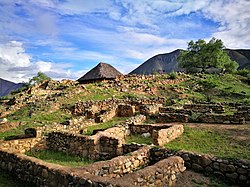From Wikipedia, the free encyclopedia
Archaeological site in Peru
Kotosh is an archaeological site near the town of Huánuco , Peru , consisting of a series of buildings comprising six periods of continuous occupation.[1]
Stratigraphy Three cultural phases which preceded the Chavin culture were identified at Kotosh,
Kotosh
Wairajirca
Mito[2] Kotosh Period The Kotosh Period culture stratum was situated directly beneath the Chavin culture stratum.
At this stage, maize cultivation has appeared.[3]
Some Kotosh elements show links with the Chavin culture. For example; stirrup spouts, plain rocker stampings, and curvilinear ceramic designs. There are also similarities in black paint on red ceramics. Kotosh Black Polished Incised pottery is similar to Classical Chavin pottery.[4]
Wairajirca Period This is when the first pottery appeared. Wayrajirca pottery was originally found at its type site Wayrajirca, and it is also known from elsewhere in the northern highlands.
It is characterized by the polished brown and black styles decorated with incisions and post-firing paint. The designs are simple and geometric; anthropomorphic figures be added at later periods.
The Kotosh Period strongly maintained the traditions of the preceding Wairajirca Period, including the ceramic tradition.
Mito period Terracota "Crossed arms" from Kotosh, 1800 BC This was the earliest identified cultural period, which was preceramic. During this period, The Temple of the Crossed Hands was first built. The image of crossed arms is characteristic for the Kotosh temple iconography.[5] [6]
Some Lauricocha culture stone tools were found in this period.
See also References
^ "Kotosh -Templo De Las Manos Cruzadas" (in Spanish). MINCETUR. Retrieved 2018-11-11 .^ Seiichi IZUMI, Pedro J. CUCULIZA, Chiaki KANO, INTRODUCTION, Bulletin No.3: EXCAVATIONS AT SHILLACOTO, HUANUCO, PERU. Archived 2003-01-13 at the Wayback Machine The University Museum, University of Tokyo, 1972
^ Encyclopedic Dictionary of Archaeology: Kotosh Springer Science & Business Media, 2000 ISBN 1475751338 ^ Izumi and Sono, 1963, p. 155
^ "Templo de las Manos Cruzadas de Kotosh" . Absolut Viajes (in Spanish). Retrieved 28 March 2020 .^ "Huanuco tourism" . Veperu (in Spanish). 2006. Archived from the original on 1 January 2010. Retrieved 28 March 2020 .
Bibliografía Del Busto Duthurburu, José Antonio : Perú preincaico , pp. 56–58. Colección de obras escogidas de José Antonio del Busto. Lima, Empresa Editora El Comercio S.A., 2011. ISBN 978-612-306-033-6 Kauffmann Doig, Federico : Historia y arte del Perú antiguo . Vol. 1, pp. 136–138. Lima, Ediciones PEISA, 2002. ISBN 9972-40-213-4 Kaulicke, Peter : El Perú Antiguo I . Los períodos arcaico y formativo, pp. 38. Colección Historia del Perú, editada por la Empresa Editora El Comercio S.A. Lima, 2010. ISBN 978-612-4069-86-4 External links
Acaray Ahuila Gencha Machay Amaru Marka Wasi Arhuaturo Asana Asiru Phat'jata Aspero Auga Punta Auquilohuagra Awkin Punta Awkimarka (Apurímac) Awkimarka (Huánuco) Aya Muqu Ayamachay Ayawayq'u Azángaro Baths of Boza Bandurria Buena Vista Cahuachi Cajamarquilla Cao Viejo Carachupa Carajía Caral Caves of Sumbay Cerro Baúl Cerro Pátapo Cerro Trinidad Chacamarca Chan Chan Chanquillo Chauchilla Cemetery Chavín de Huantar Chawaytiri Cheqollo Chichakuri Chipaw Marka Choquepuquio Choquequirao Choquequirao Puquio Churajón Chuya Cochabamba Cochapata Colcampata Collor Condorcaga Cota Coca Coricancha Cumbemayo Cutimbo El Brujo El Cañoncillo El Ingenio El Paraíso Garagay Gran Pajatén Gran Vilaya Guellayhuasin Guitarrero Cave Hatun Machay Hatun Misapata Hatun Rumiyoc Hatun Uchku Hatun Usnu Hatunmarka Honcopampa Huaca de la Luna Huaca del Dragón Huaca del Sol Huaca Huallamarca Huaca Prieta Huaca Pucllana Huaca San Marcos Huaca Santa Ana Huacramarca Hualpayunca Huamanmarca, La Convención Huamboy Huankarán Huaycán de Pariachi Huánuco Pampa Huari Huayna Picchu Huayrapongo Huchuy Qosqo Huiñao Inca Uyo Incahuasi, Lima Ingatambo Inka Mach'ay Inka Raqay, Apurímac Inka Raqay, Ayacucho Inka Tampu, Huayopata Inka Tampu, Vilcabamba Inka Tunuwiri Inka Wasi, Ayacucho Inka Wasi, Huancavelica Inkapintay Inkilltambo Inti Punku Inti Watana, Ayacucho Inti Watana, Calca Inti Watana, Urubamba Intikancha Intini Uyu Pata Intipa Ñawin Intiyuq K'uchu Iskuqucha Isog Jinkiori Jisk'a Iru Muqu Kanamarka Kanichi Kenko Killa Mach'ay Killarumiyuq Kotosh Kuelap Kukuli Kuntur Wasi Kunturmarka, Ayacucho Kunturmarka, Pasco Kuntuyuq Kusichaka valley Khichuqaqa Khuchi Mach'ay K'allapayuq Urqu K'ipakhara Laguna de las Momias Lauricocha Caves Layzón Llactan Llamachayuq Llamachayuq Qaqa Llamayuq Llamuqa Llaqta Qulluy, Acoria Llaqta Qulluy, Conayca Llaqta Qulluy, Tayacaja Llaqta Qulluy, Vilca Llaqtapata Machu Colca Machu Picchu Machu Pirqa Machu Pitumarka Machu Q'inti Mallkuamaya Mameria Maray Qalla Marayniyoq Marcahuamachuco Markahirka Markansaya Markapukyu Marpa Mawk'allaqta, Castilla Mawk'allaqta, Espinar Mawk'allaqta, La Unión Mawk'allaqta, Melgar Mawk'allaqta, Paruro Mawk'allaqta, Sandia Mawk'ataray Mazur Miculla Millka Miraflores Mirq'imarka Miyu Pampa Molloko Moray Mulinuyuq Mullu Q'awa Muyu Muyu Muyu Urqu Muyuq Marka Nazca Lines Nina Kiru Ninamarca Ñawpallaqta, Huanca Sancos Ñawpallaqta, Fajardo Ñawpallaqta, Lucanas Ñusta Hispana Ollantaytambo Pacatnamu Pachacamac Pachatusan Paiján Pañamarca Paracas Candelabra Paraccra Patallaqta Pikillaqta Pikimach'ay Pilluchu Pinkuylluna Pirca Pirca, La Libertad Pirca Pirca, Lima Pirhuaylla Piruro Pirwayuq Písac Puka Pukara Puka Tampu Puka Urqu Pukara, Coporaque Pukara, Fajardo Pukara, Puno Pukara, Vilcas Huamán Pukarani Pumamarka, San Sebastián Pumamarka, Urubamba Pumaq Hirka Pumawasi Punkuri Puqin Kancha Puruchuco Purunllacta, Cheto Purunllacta, Soloco Pusharo Pusuquy Pata Puyupatamarca Qaqapatan Qenko Qillqatani Qillqa Qillqay Mach'ay Quiaca Quillarumi Quishuar Qullqapampa Qulu Qulu Qunchamarka Qunchupata Quri Winchus Qurimarka, Apurímac Qurimarka, Cusco Quriwayrachina, Anta Quriwayrachina, Ayacucho Quriwayrachina, La Convención Qasa Pata Qhapaq Kancha Raqch'i Revash Rumicolca Rumiwasi Runayoc Runkuraqay Sacsayhuamán Sara Sara Sayacmarca Sayhuite Sechín Sillustani Sipán Sóndor Soro Mik'aya Patjxa Susupillu Tambo Totem Tambomachay Tampu Mach'ay, Huancavelica Tampukancha Tanqa Tanqa Tantarica Taqrachullu Tarahuasi Tarmatambo Templo del Zorro The Toads of Wiraqucha Tikra Tinyaq Tipón Titiqaqa Toquepala Caves Toro Muerto Trinchera Túcume Tunanmarca Tunay Q'asa Tupu Inka T'akaq T'uqu T'uquyuq Uchkus Inkañan Urpish Uskallaqta Usnu, Ayacucho Usnu, Huánuco Usnu Muqu Usqunta Uyu Uyu Venado cautivo Ventanillas de Otuzco Ventarron Vilcabamba Vilcashuamán Viracochapampa Vitcos Waman Pirqa Wamanilla Wamanmarka, Chumbivilcas Wamanmarka, Lima Wanakawri, Cusco Wanakawri, Huánuco Waqlamarka Waqra Pukara Waqutu Warahirka Waraqayuq Waraqu Urqu Warawtampu Wari Willka Waruq Wat'a, Cusco Wat'a, Huánuco Wayna Q'inti Wayna Tawqaray Wichama Wichqana Wich'un Wila Wilani Wilca Wilcahuaín Willkaraqay Wiñay Wayna Wiraqucha Pirqa Yanaca Yanaqi - Qillqamarka Yaynu Yuraq Mach'ay
9°55′51″S 76°16′46″W / 9.93083°S 76.27944°W / -9.93083; -76.27944



